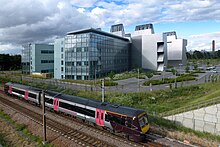
Back Laboratory of Molecular Biology German Laboratory of Molecular Biology French MRC分子生物学研究所 Japanese 분자생물학 연구소 Korean Laboratory of Molecular Biology SIMPLE Phòng Thí nghiệm Sinh học Phân tử MRC Vietnamese 分子生物学实验室 Chinese
 The new building of the LMB viewed from the Cambridgeshire Guided Busway bridge in June 2013 | |
| Abbreviation | MRC LMB |
|---|---|
| Location |
|
| Coordinates | 52°10′35″N 0°08′35″E / 52.1763°N 0.1430°E |
| Fields | Molecular biology |
Director | Jan Löwe |
Parent organization | Medical Research Council |
| Website | www2 |
The Medical Research Council (MRC) Laboratory of Molecular Biology (LMB) is a research institute in Cambridge, England, involved in the revolution in molecular biology which occurred in the 1950–60s. Since then it has remained a major medical research laboratory at the forefront of scientific discovery, dedicated to improving the understanding of key biological processes at atomic, molecular and cellular levels using multidisciplinary methods, with a focus on using this knowledge to address key issues in human health.[1][2][3]
A new replacement building constructed close by to the original site on the Cambridge Biomedical Campus was opened by Queen Elizabeth II in May 2013.[4] The road outside the new building is named Francis Crick Avenue after the 1962 joint Nobel Prize winner and LMB alumnus, who co-discovered the helical structure of DNA in 1953.[5]
- ^ "MRC Laboratory of Molecular Biology". www.ukri.org. Retrieved 1 March 2022.
- ^ Brackley, Paul (12 December 2018). "Dr Jan Löwe on the next scientific frontier for the MRC Laboratory of Molecular Biology". Cambridge Independent. Retrieved 1 March 2022.
- ^ Brackley, Paul (14 February 2018). "Dr Jan Löwe says he's 'humbled' to take over as director of MRC Laboratory of Molecular Biology". Cambridge Independent. Retrieved 1 March 2022.
- ^ Cite error: The named reference
Openingwas invoked but never defined (see the help page). - ^ Finch, John (2013). A Nobel Fellow On Every Floor : a History of the Medical Research Council Laboratory of Molecular Biology. New York: Icon Books. pp. 27–30. ISBN 978-1-84831-670-6. OCLC 865330798.